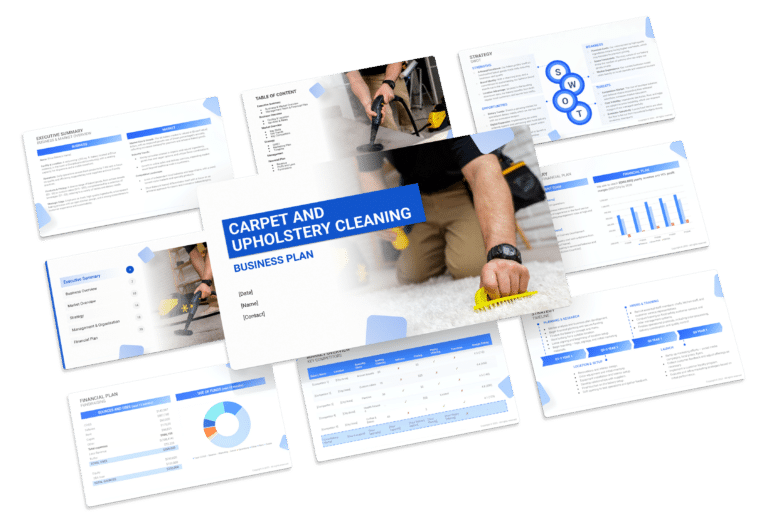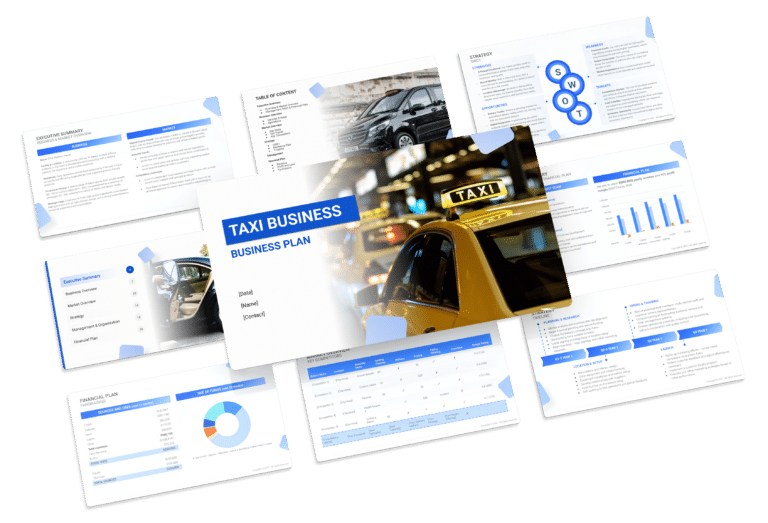Construction Contractor Business Plan Template & PDF Example

Creating a comprehensive business plan is crucial for launching and running a successful construction contractor business. This plan serves as your roadmap, detailing your vision, operational strategies, and financial plan. It helps establish your construction contractor business’s identity, navigate the competitive market, and secure funding for growth.
This article not only breaks down the critical components of a construction contractor business plan, but also provides an example of a business plan to help you craft your own.
Whether you’re an experienced entrepreneur or new to the service industry, this guide, complete with a business plan example, lays the groundwork for turning your construction contractor business concept into reality. Let’s dive in!
The Plan
Our construction contractor business plan is meticulously structured to include all essential aspects necessary for a robust strategy. It outlines the company’s operations, marketing strategy, market environment, competitors, management team, and financial projections.
- Executive Summary: Presents an overview of your construction contractor business concept, including market analysis, management structure, and financial strategies.
- Business Overview: Provides detailed information on your construction contractor services and operational model:
- Company Information: Describes the company’s foundation, areas of expertise in the construction industry, and the operational standards that define the business.
- Services: Details the comprehensive range of construction services offered, from residential building to commercial projects, including any specialized services such as eco-friendly constructions or renovations.
- Target Market: Outlines the specific demographic and geographic segments the company aims to serve, emphasizing any particular needs of these markets like affordability, durability, or luxury finishes.
- Market Overview: Analyzes the construction industry landscape, pinpointing competitors and how your company distinguishes itself:
- Key Stats: Provides statistics on the construction industry’s size and growth trends relevant to your market area.
- Key Trends: Identifies significant trends affecting the construction sector.
- Key Competitors: Evaluates primary competitors in the area and outlines your competitive advantages.
- Strategy: Details how the construction contractor plans to achieve growth and attract clients:
- SWOT: Conducts a Strengths, Weaknesses, Opportunities, and Threats analysis.
- Marketing Plan: Outlines effective strategies for attracting and retaining clients.
- Timeline: Lists key milestones and objectives from the start-up through the initial years of operation.
- Management: Shares information about the management team, detailing who manages the company and their respective roles.
- Financial Plan: Forecasts the company’s 5-year financial performance, including revenue, profits, and significant expenses.

Executive Summary
The Executive Summary introduces your construction contractor’s business plan, offering a concise overview of your company and its services. It should detail your market positioning, the range of construction and remodeling services you offer, its location, size, and an outline of day-to-day operations.
This section should also explore how your construction business will integrate into the local market, including the number of direct competitors within the area, identifying who they are, along with your company’s unique selling points that differentiate it from these competitors.
Furthermore, you should include information about the management and co-founding team, detailing their roles and contributions to the company’s success. Additionally, a summary of your financial projections, including revenue and profits over the next five years, should be presented here to provide a clear picture of your construction business’s financial plan.
Construction Contractor Business Plan Executive Summary Example

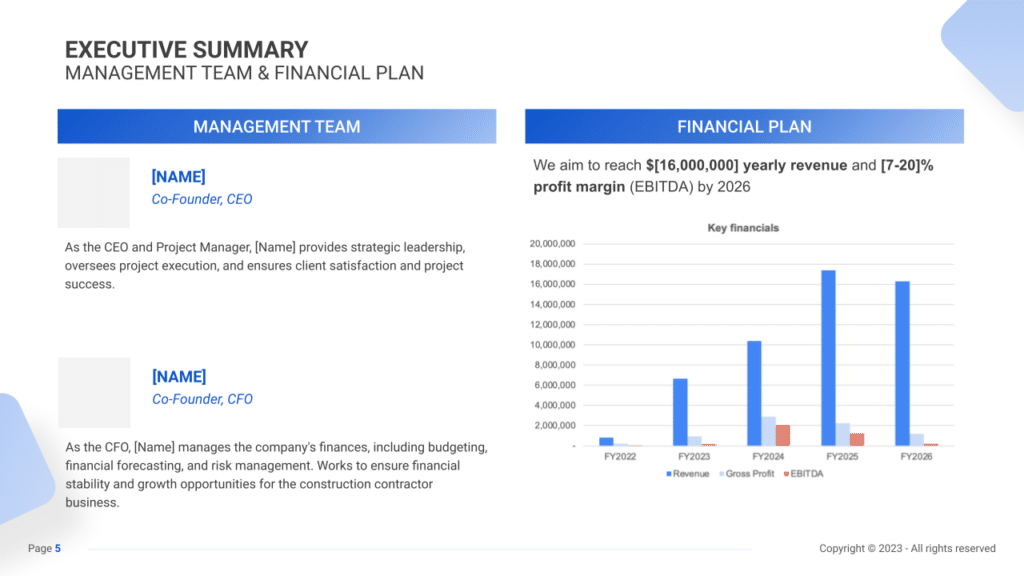
Business Overview
When detailing the business overview in your executive summary, it’s crucial to provide clear and concise information. This includes the name of your construction company, its location, and an overview of the types of construction projects you undertake.
These details not only introduce your business but also set the stage for its unique qualities. Indeed, a unique selling proposition (USP) is what sets your construction company apart from the competition. Whether it’s your expertise in green building practices, your use of cutting-edge technologies like BIM, or your focus on client-centric service, your USP should be a focal point of your executive summary. It’s what captures the interest of your audience and showcases the unique value your business brings to the market.
Example:
For instance, “Superior Builds,” located in the industrial hub of Metro City, operates from a well-equipped office on Builders Lane. Established in 2010, they specialize in commercial and residential projects, incorporating sustainable building practices and advanced technologies such as BIM. Their USP is their commitment to eco-friendly construction methods, which not only appeal to environmentally conscious clients but also provide long-term value through energy efficiency.
Market Overview
Understanding and presenting the market size, growth trends, and industry dynamics are integral parts of the market analysis.
This section should highlight the potential of the U.S. construction market, backed by relevant data like market value and growth rates. Discussing industry trends, such as the adoption of green building materials and BIM, provides insight into the evolving landscape and where your construction company fits within it.
Equally important is the competitive landscape. Your executive summary should identify key competitors and explain how your construction company positions itself in this environment. Whether you focus on specialized construction services, superior project management, or innovative construction solutions, this is your opportunity to showcase how your company is poised to stand out in a crowded market.
Example:
Consider “Superior Builds” within the general contractor industry, part of a $112 billion market. Despite intense competition from 493,728 companies nationwide, “Superior Builds” differentiates itself by focusing on sustainable building solutions and advanced project management using BIM, catering to a growing segment of the market that values environmental responsibility and efficiency.
Management Team
The management team’s background and expertise are significant assets to your business. In your executive summary, highlight the key qualifications and experiences of your team members.
This might include the CEO’s extensive background in sustainable construction or the CFO’s expertise in financial management within the construction industry. Demonstrating the team’s expertise not only builds credibility but also assures potential investors and partners of your construction company’s capability to succeed.
Example:
At “Superior Builds,” the team is led by CEO John Carter, a pioneer in green construction with over 20 years of industry experience, and CFO Linda Smith, who has a robust track record of managing finances for large-scale construction projects. Their combined expertise ensures the company’s strategic positioning and operational efficiency.
Financial Plan
The financial plan overview should succinctly summarize your financial goals and projections, including revenue targets and profit margins, to provide a clear picture of your construction company’s financial trajectory.
Example:
“Superior Builds” aims for $16 million in annual revenue by 2026, with a profit margin of 7-20%. The financial strategy includes leveraging high-profile, sustainable construction projects and expanding into new markets, with sales growth driven by a strong reputation and strategic partnerships, positioning the company for profitability and industry leadership within the next few years.
Business Overview
For a construction contractor, the Business Overview section can be concisely divided into 3 main slides:
Company Information & Location
Our construction company specializes in handling diverse projects, including residential, commercial, and industrial builds. Located strategically near major transport hubs, our headquarters offer easy access to key construction sites, providing logistical benefits and enhanced service delivery to our clientele.
Services & Specialization
We offer a comprehensive range of services from general contracting to specialized projects like energy-efficient constructions. Our expertise in custom designs and turnkey solutions sets us apart in the industry, ensuring high-quality project management and client satisfaction.
Target Market
Our target market includes homeowners, real estate developers, and public sector contracts. We cater to clients seeking reliable, high-quality construction services, with a focus on innovation and efficiency to meet the unique needs of each segment, ensuring we are the go-to contractor for diverse construction demands.
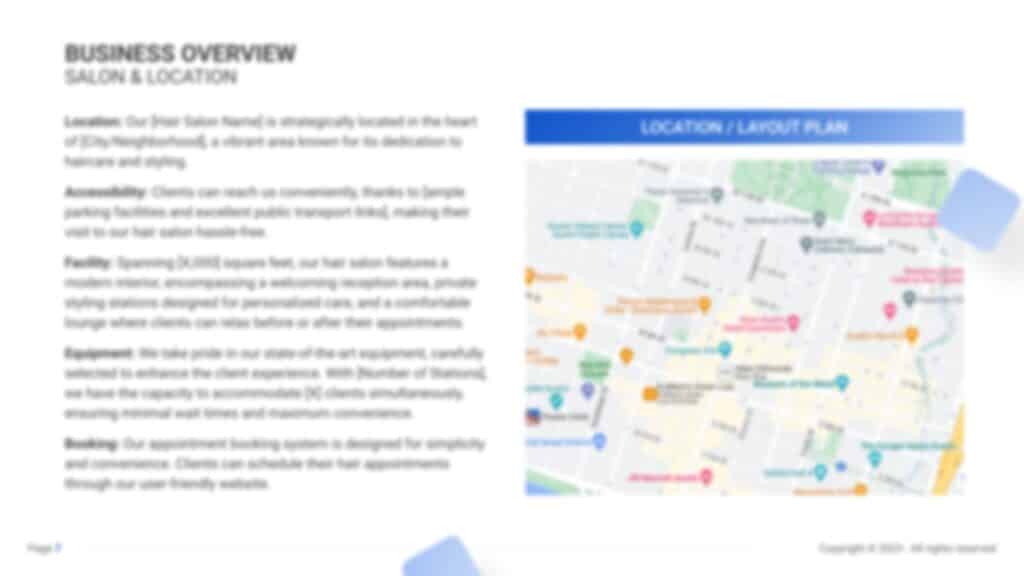
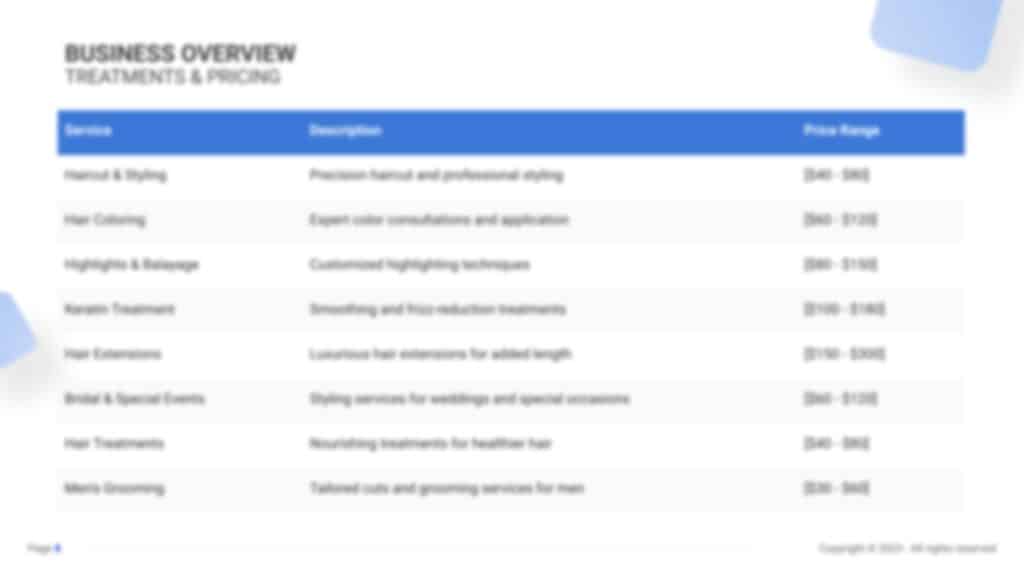
Market Overview

Industry Size & Growth
In the Market Overview of your construction contractor business plan, start by examining the size of the construction industry and its growth potential. This analysis is crucial for understanding the market’s scope and identifying expansion opportunities.
Key Market Trends
Proceed to discuss recent market trends, such as the increasing consumer interest in sustainable building practices, energy-efficient homes, and smart technology integration in construction. For example, highlight the demand for green building certifications and the rising popularity of renovations that focus on improving energy efficiency.
Competitive Landscape
A competitive analysis is not just a tool for gauging the position of your construction contractor in the market and its key competitors; it’s also a fundamental component of your business plan.
This analysis helps in identifying your construction contractor’s unique selling points, essential for differentiating your business in a competitive market.
In addition, the competitive analysis is integral in laying a solid foundation for your business plan. By examining various operational aspects of your competitors, you gain valuable information that ensures your business plan is robust, informed, and tailored to succeed in the current market environment.
Identifying Your Competitors in the Construction Industry
The initial step in a competitive analysis is recognizing who your competitors are. Start by identifying other local construction contractors, especially those who specialize in the same type of projects as your business, such as residential building or commercial renovations. Also, consider larger construction firms and indirect competitors like DIY stores or prefabricated building suppliers.
Utilize tools like Google Maps for a geographical overview of where competitors are located. Platforms like Yelp and Angie’s List can provide customer testimonials and ratings, giving you an insight into your competitors’ strengths and weaknesses. For instance, if multiple reviews praise the reliability and craftsmanship of “Quality Constructions,” this is a significant strength of your competitor.

Construction Competitors’ Strategies
To understand the competitive landscape, consider several factors:
- Project Portfolio: Review the variety of projects completed by competitors. If “Green Build Contractors” are gaining traction for their eco-friendly building solutions, it suggests a market trend towards sustainable construction.
- Building Techniques: Evaluate the construction methodologies used. A contractor like “Heritage Builders” that excels in restoring historical properties might attract a niche market compared to “Innovate Structures,” known for employing state-of-the-art building technologies.
- Pricing Strategy: Compare your pricing with that of your competitors. Are your services priced competitively with “Budget Builders,” or do they align with the high-end services of “Elite Constructions”?
- Marketing Tactics: Examine how competitors market their services. Do they leverage robust digital marketing strategies, or do they depend on referrals and local advertising?
- Customer Relations: Assess the quality of customer service offered. For example, “Client-Centric Constructions” may be favored for its customer-focused approach and excellent project management.
- Operational Efficiency: Notice if competitors use advanced technology or innovative practices to enhance efficiency, such as “Streamline Construction” with its integrated project management software.
What’s Your Construction Contractor’s Value Proposition?
Reflect on what makes your construction contracting business unique. Perhaps you are known for your rapid turnaround times, or maybe you specialize in luxury residential renovations that are unmatched in your region.
Identify market gaps through client feedback and industry trends. For instance, the increasing demand for smart homes and energy-efficient buildings might be a lucrative opportunity if competitors have not yet fully embraced this niche.
Consider your location: A contractor in a rapidly developing urban area might focus on commercial and high-density residential projects, while one in a more rural setting might specialize in custom homes and renovations that align with the local aesthetic.
Strategy

SWOT
First, conduct a SWOT analysis for the construction contractor, highlighting Strengths (such as advanced project management skills and a wide array of building services), Weaknesses (including dependency on the economic cycle and market competition), Opportunities (for example, growing trends in sustainable construction and smart home technologies), and Threats (such as potential economic recessions that may reduce investment in new construction projects).

Marketing Plan
Next, develop a marketing strategy that outlines how to attract and retain clients through targeted advertising, promotional discounts, strong online presence, and community involvement. Focus on showcasing your company’s unique capabilities and successful project completions to build trust and credibility in the market.
Marketing Channels
Utilize various marketing channels to increase brand awareness, engage potential clients, and secure construction projects.
Digital Marketing
Embrace online platforms to expand your reach:
- Website Optimization: Create a professional website showcasing your portfolio, client testimonials, and a blog featuring industry insights and project case studies. Implement SEO strategies to improve your website’s visibility in search results.
- Social Media Presence: Utilize platforms like LinkedIn for professional networking, Instagram and Pinterest to showcase completed projects, and YouTube for construction project walkthroughs or tutorials.
- Email Marketing: Build an email subscriber list by offering valuable content such as construction tips, project spotlights, and industry updates. Send regular newsletters to maintain engagement.
Local Advertising
Connect with your local community:
- Networking Events: Attend local trade shows, industry conferences, and business networking events to establish connections with potential clients, architects, and developers.
- Community Engagement: Sponsor community events, participate in local charity initiatives, or offer workshops related to construction and home improvement to increase visibility and build trust.
- Print Media and Direct Mail: Advertise in local newspapers, and magazines, or send direct mailers showcasing your construction projects and services to targeted neighborhoods.
Partnerships and Collaborations
Leverage collaborations to expand your reach:
- Industry Partnerships: Collaborate with architects, interior designers, real estate agents, or suppliers to create referral programs or joint marketing initiatives.
- Client Referral Program: Incentivize existing clients to refer your construction services by offering discounts or rewards for successful referrals.
Promotional Activities
Attract potential clients with enticing offers:
- Seasonal Promotions: Introduce seasonal promotions like ‘Spring Renovation Specials’ or ‘Summer Outdoor Remodeling Deals’ to generate interest and urgency.
- Free Consultations: Offer free initial consultations to prospective clients, providing insights and recommendations, showcasing your expertise, and building rapport.
- Limited-Time Discounts: Create limited-time offers for larger projects or exclusive discounts for early project bookings.

Sales Channels
Deploy effective sales strategies to convert leads into projects and maximize revenue.
Consultative Selling
Develop relationships with potential clients:
- Client Education: Provide comprehensive information about construction processes, materials, and project timelines to build trust and credibility.
- Tailored Proposals: Customize proposals that address the specific needs and preferences of potential clients, showcasing your expertise and understanding of their project requirements.
- Project Add-Ons: Suggest additional services or features that could enhance the value of the project during client interactions or proposal presentations.
Client Relationship Management
Focus on client retention and satisfaction:
- Post-Project Follow-ups: Conduct follow-ups after project completion to ensure client satisfaction and address any concerns promptly.
- Referral Requests: Ask satisfied clients for referrals and testimonials that can be used in future marketing efforts.
- Customer Service Excellence: Prioritize exceptional customer service throughout the project lifecycle to foster long-term client relationships.
Technology Integration
Leverage technology for efficiency and convenience:
- Project Management Tools: Utilize software or applications for project scheduling, progress tracking, and communication with clients to ensure transparency and efficiency.
- Online Project Quoting: Implement online quoting tools or calculators on your website to provide quick estimates, streamlining the initial inquiry process for potential clients.
- Virtual Presentations: Use virtual meeting platforms to conduct project presentations, share design concepts, and collaborate with clients remotely.
Strategy Timeline
Finally, create a detailed timeline that outlines critical milestones for the construction business’s project completions, marketing initiatives, client relationship building, and expansion objectives, ensuring the business progresses with clear direction and purpose.

Management
The Management section focuses on the construction contractor business’s management and their direct roles in daily operations and strategic direction. This part is crucial for understanding who is responsible for making key decisions and driving the construction contractor business toward its financial and operational goals.
For your construction contractor business plan, list the core team members, their specific responsibilities, and how their expertise supports the business.


Financial Plan
The Financial Plan section is a comprehensive analysis of your financial projections for revenue, expenses, and profitability. It lays out your construction contractor business’s approach to securing funding, managing cash flow, and achieving breakeven.
This section typically includes detailed forecasts for the first 5 years of operation, highlighting expected revenue, operating costs and capital expenditures.
For your construction contractor business plan, provide a snapshot of your financial statement (profit and loss, balance sheet, cash flow statement), as well as your key assumptions (e.g. number of customers and prices, expenses, etc.).
Make sure to cover here
_ Profit and Loss
_ Cash Flow Statement
_ Balance Sheet
_ Use of Funds






